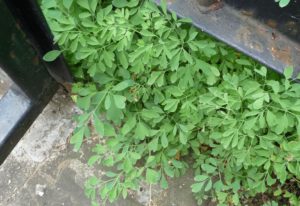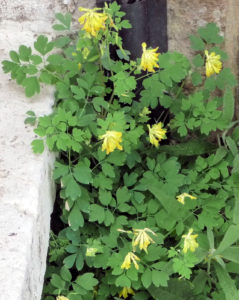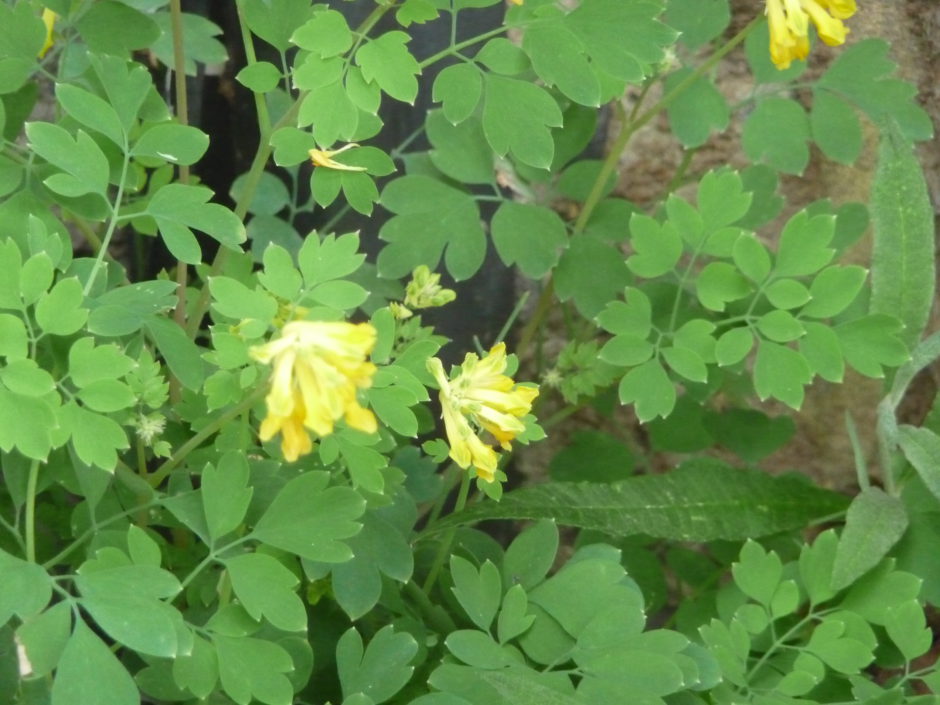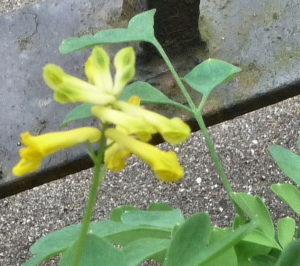YELLOW FUMITORY (Corydalis lutea)
Southern Europe
Originating at the foot of the Alps, this perennial is fond of rocks & the crevices between them, preferring moist but free-draining soil in full sun to part shade. The delicate green foliage of Yellow fumitory resembles that of Maidenhair fern.
Small mounds of Yellow Fumitory nestle in many Highbury front gardens, including our own. In May, spurred tubular YELLOW flowers appear amongst the greenery; they bloom until October.
The plant is untroubled by pests or diseases. It does not tolerate high temperatures in summer or wet soils during winter, & resents being transplanted. In the 2018 heatwave, all flowers lay on the ground beneath the plant. No further flowers were produced until cooler weather returned.
http://www.wildlifetrusts.org/species/yellow-corydalis
http://www.finegardening.com/yellow-corydalis-corydalis-lutea
Historical
“grown as an ornamental in the British Isles since late in the sixteenth century. It was first recorded in the wild in 1796 and became widespread early in the next century. In recent times it has expanded its distribution throughout the British Isles, although it remains little recorded in the Irish Republic. As yellow corydalis has spread it seems to have adapted to new habitats; once it was restricted to crevices in walls and similar situations, now, in London at least, it seems able to colonise any bare ground. It is possible that climate change is stimulating greater seed production.”
http://www.plant-lore.com/plantofthemonth/yellow-corydalis/

Other names: Crested Lark (from the Greek korydalis), Fingers-and-thumbs, Hollowort, Italian weed (because it was ‘said to follow the Romans’), Kitty Barnard, Lady’s pincushion, Mother-of-thousands, Pincushion, Poppers, Psuedofumaria lutea, Rock fumewort, Yellow Bleeding Heart, Yellow Corydalis, Yellow Larkspur, Yellow Wall Fumitory.
fumitory
“John Gerard in his 1597 Herball speculated the name was applied to it because it caused one’s eyes to water as would smoke, though this seems an unlikely origin. Other theories are that it was once used as a fumigant, & the name lasted longer than the practice. Some commentators state that it was in medieval times burnt during exorcism rites or spells of witchcraft, though the evidence of this being so appears to be strictly folkloric. In 1820, John Hill alleged that it was dried & smoked like tobacco as a treatment for headache. Or it was from ancient times believed that species of fumitories sprang up spontaneously in fields of barley, without benefit of seeding itself, like smoke seeping from cracks in the earth, therefore was called “The Smoke of the Earth.”

“Yellow Corydalis – I’ve wondered if it mightn’t once have been used in sybilline rites, the translucent white corms having psychotropic properties of inducing visions, & sybils dwelt often in caverns with a smoky hearth. I’ve no good basis for this notion, though Fumitory is derived from fumiterre meaning “the smoke of the earth,” which is possibly a very ancient religious allusion to sacred caverns with volcanic vents, or sybils with their cavern hearth rituals.”
PAGHAT’S GARDEN (PAGHAT THE RATGIRL)
http://www.paghat.com/corydalisyellow.html


